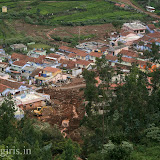Coonoor Singara Estate Road
The picture perfect monsoon mood that is conjured up in the movies of the mountains flacked by moving mist, smog and the occasional wind swept drizzle is all but in the reel world. In the real world what does the Great Indian Monsoon means to people of Nilgiris. For us it is more of a “love hate” relationship as the better part of the year is consumed by both the SE – NW - Monsoon - it obliviate life every time monsoon sets in - to reconcile the ways and means to counter the monsoon rains over and over again – it is a way of life no doubt, a habitual acclimation of sort for the resident is more cumbersome and comes with a ritual cribbing as they gradually ease in to the monsoon mode. what with intensive cloud cover, one hardly sees the sun rays hit the earth for weeks together, dampness and moist clothing to put up with as it hardly dries, if one dwells in homes with old Mangalore tiled roofing it is (most of us do) then of all probability it will leak, seep and will splotch with droplets.
Left with the smaller side of the Monsoon as the peak months of June and July are behind us now, having yielded below normal rains then forcasted for this year let alone year on year. In the ecological front if one has observed the pattern of monsoon for last 8 to 10 years it is pretty evident that there has been a major shift in Nilgiris climate pattern one that stands out conspicuously is the window of second season which has vanished and both the monsoons have merged – every thing in its severity is has been the order of the day. Heavier rains in the monsoons, summer getting hotter with ever souring temperature. The monsoon is now expected more so with some kind of mechanical precession with the every passing year the weather department is forecasting the precise date the monsoon sets in - fairly it is been the case for more then 8 to 10 years now that we have received reasonable monsoon as expected. In the face of it I keep pondering over the thought of “expecting the nature to perform on any given time” Now can it perform to our demanding needs ? with so much of influence like the El Ninos, The Greenhouse Effect and the vanishing green cover. In the probability of the monsoon skipping out for a year – imagine what will be the arising scenario? Total devastation a precarious scenario whereby our storage facilities is churned out on hand to mouth basis. The last time monsoon gave a break for a year the scenario wasn't as demanding as now but that was 10 year before. What we will see is chaos every where, the obvious blame game, committees upon committees special task force core working groups (bureaucratically buying time, and excuse “WE ARE WORKING ON IT” ), the green crowd given a hearing and massive fund infused to do major forestry, de-silting dams, reservoirs lil bit of framer pleasing finally the sizable chunk of the fund will end up with crooks masquerading as Realtors. And can we have a plan B here if so what kind of contingency can we plan to fill up in place of the monsoon a blatant management theory here to ask for a contingency plan for nature (sic a contingency plan for “nature”, thou one can be better equipped to face it but cannot replace it) ~ it is like being parched on top of the cliff and expecting every time a copter to rescue us.
That precarious Year is not far off from us, will eventually dance to the tune of Nature until then I await the arrival of the Monsoon dampness mountains flacked by moving mist, smog, the occasional wind swept drizzle et al


















